Strategies of Managing Talent for Attraction and Retention at Tesco
VerifiedAdded on 2022/11/29
|29
|5148
|74
Report
AI Summary
This report examines talent management strategies, specifically focusing on Tesco's approach to attracting and retaining employees. The report begins with project planning, outlining the aim, objectives, and research questions, along with a project management plan including cost, scope, and risk assessment. It then details the research methodology, which includes primary data collection through questionnaires and secondary data analysis from various sources. The findings are presented using frequency tables and pie charts, analyzing employee perceptions on the importance of talent management and the strategies employed by Tesco and its competitors. The report also includes reflective practices and a performance appraisal template. The conclusion summarizes the key findings and recommendations. The report emphasizes the importance of talent management in enhancing employee skills, improving competitive strength, and fostering a positive workplace environment. References and appendices, including PowerPoint screenshots and a performance review template, are included to support the analysis.
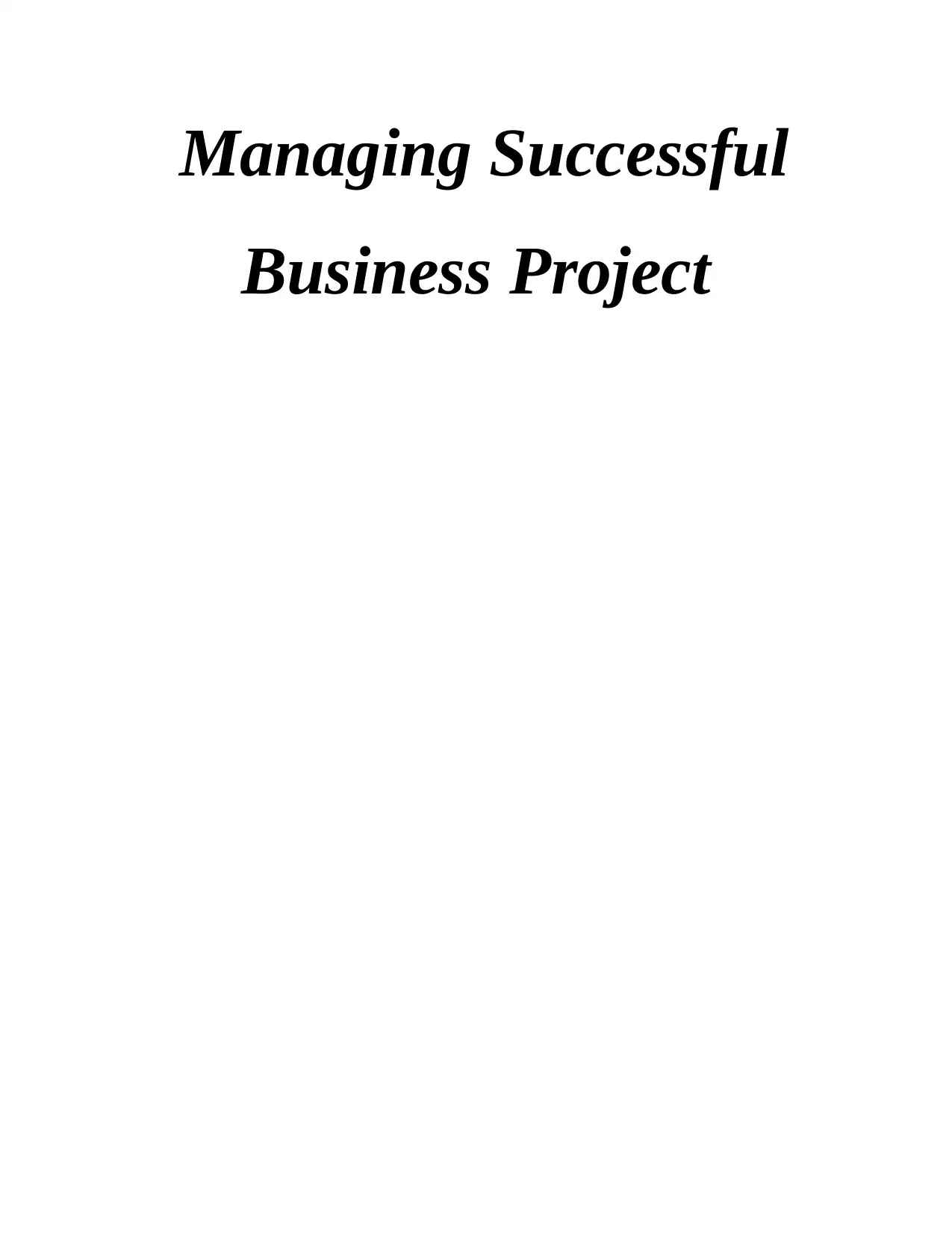
Managing Successful
Business Project
Business Project
Paraphrase This Document
Need a fresh take? Get an instant paraphrase of this document with our AI Paraphraser
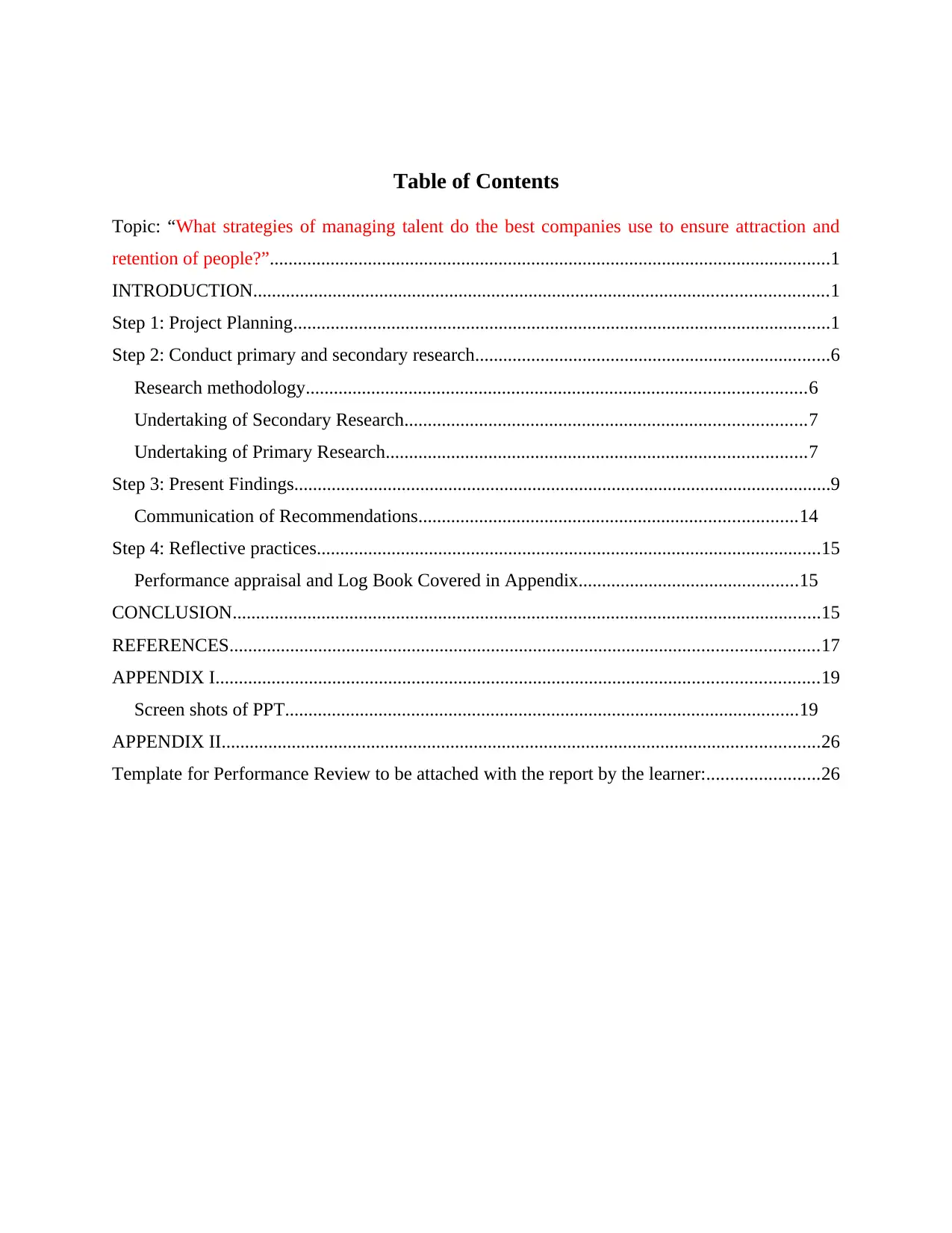
Table of Contents
Topic: “What strategies of managing talent do the best companies use to ensure attraction and
retention of people?”........................................................................................................................1
INTRODUCTION...........................................................................................................................1
Step 1: Project Planning...................................................................................................................1
Step 2: Conduct primary and secondary research............................................................................6
Research methodology...........................................................................................................6
Undertaking of Secondary Research......................................................................................7
Undertaking of Primary Research..........................................................................................7
Step 3: Present Findings...................................................................................................................9
Communication of Recommendations.................................................................................14
Step 4: Reflective practices............................................................................................................15
Performance appraisal and Log Book Covered in Appendix...............................................15
CONCLUSION..............................................................................................................................15
REFERENCES..............................................................................................................................17
APPENDIX I.................................................................................................................................19
Screen shots of PPT..............................................................................................................19
APPENDIX II................................................................................................................................26
Template for Performance Review to be attached with the report by the learner:........................26
Topic: “What strategies of managing talent do the best companies use to ensure attraction and
retention of people?”........................................................................................................................1
INTRODUCTION...........................................................................................................................1
Step 1: Project Planning...................................................................................................................1
Step 2: Conduct primary and secondary research............................................................................6
Research methodology...........................................................................................................6
Undertaking of Secondary Research......................................................................................7
Undertaking of Primary Research..........................................................................................7
Step 3: Present Findings...................................................................................................................9
Communication of Recommendations.................................................................................14
Step 4: Reflective practices............................................................................................................15
Performance appraisal and Log Book Covered in Appendix...............................................15
CONCLUSION..............................................................................................................................15
REFERENCES..............................................................................................................................17
APPENDIX I.................................................................................................................................19
Screen shots of PPT..............................................................................................................19
APPENDIX II................................................................................................................................26
Template for Performance Review to be attached with the report by the learner:........................26
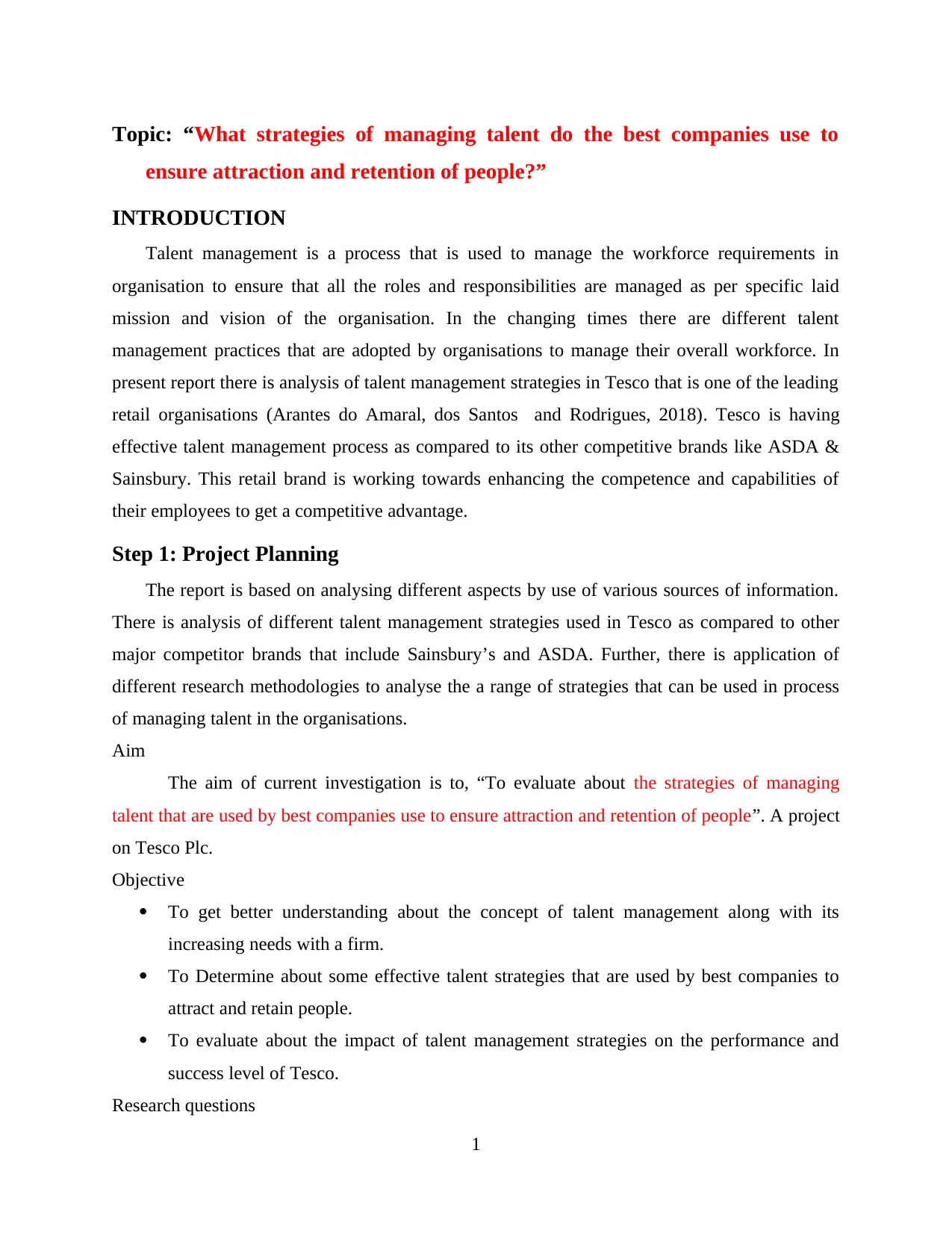
Topic: “What strategies of managing talent do the best companies use to
ensure attraction and retention of people?”
INTRODUCTION
Talent management is a process that is used to manage the workforce requirements in
organisation to ensure that all the roles and responsibilities are managed as per specific laid
mission and vision of the organisation. In the changing times there are different talent
management practices that are adopted by organisations to manage their overall workforce. In
present report there is analysis of talent management strategies in Tesco that is one of the leading
retail organisations (Arantes do Amaral, dos Santos and Rodrigues, 2018). Tesco is having
effective talent management process as compared to its other competitive brands like ASDA &
Sainsbury. This retail brand is working towards enhancing the competence and capabilities of
their employees to get a competitive advantage.
Step 1: Project Planning
The report is based on analysing different aspects by use of various sources of information.
There is analysis of different talent management strategies used in Tesco as compared to other
major competitor brands that include Sainsbury’s and ASDA. Further, there is application of
different research methodologies to analyse the a range of strategies that can be used in process
of managing talent in the organisations.
Aim
The aim of current investigation is to, “To evaluate about the strategies of managing
talent that are used by best companies use to ensure attraction and retention of people”. A project
on Tesco Plc.
Objective
To get better understanding about the concept of talent management along with its
increasing needs with a firm.
To Determine about some effective talent strategies that are used by best companies to
attract and retain people.
To evaluate about the impact of talent management strategies on the performance and
success level of Tesco.
Research questions
1
ensure attraction and retention of people?”
INTRODUCTION
Talent management is a process that is used to manage the workforce requirements in
organisation to ensure that all the roles and responsibilities are managed as per specific laid
mission and vision of the organisation. In the changing times there are different talent
management practices that are adopted by organisations to manage their overall workforce. In
present report there is analysis of talent management strategies in Tesco that is one of the leading
retail organisations (Arantes do Amaral, dos Santos and Rodrigues, 2018). Tesco is having
effective talent management process as compared to its other competitive brands like ASDA &
Sainsbury. This retail brand is working towards enhancing the competence and capabilities of
their employees to get a competitive advantage.
Step 1: Project Planning
The report is based on analysing different aspects by use of various sources of information.
There is analysis of different talent management strategies used in Tesco as compared to other
major competitor brands that include Sainsbury’s and ASDA. Further, there is application of
different research methodologies to analyse the a range of strategies that can be used in process
of managing talent in the organisations.
Aim
The aim of current investigation is to, “To evaluate about the strategies of managing
talent that are used by best companies use to ensure attraction and retention of people”. A project
on Tesco Plc.
Objective
To get better understanding about the concept of talent management along with its
increasing needs with a firm.
To Determine about some effective talent strategies that are used by best companies to
attract and retain people.
To evaluate about the impact of talent management strategies on the performance and
success level of Tesco.
Research questions
1
⊘ This is a preview!⊘
Do you want full access?
Subscribe today to unlock all pages.

Trusted by 1+ million students worldwide
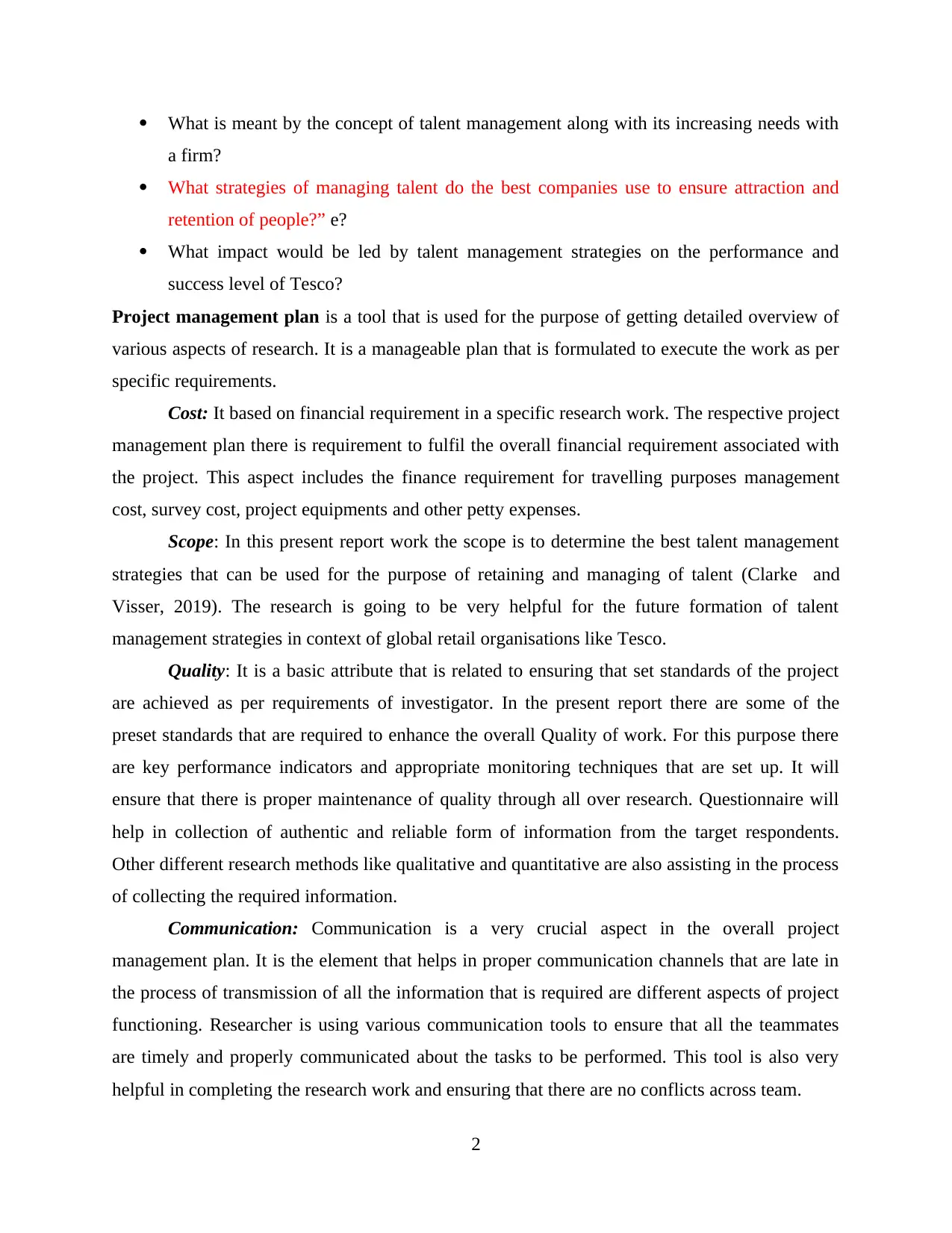
What is meant by the concept of talent management along with its increasing needs with
a firm?
What strategies of managing talent do the best companies use to ensure attraction and
retention of people?” e?
What impact would be led by talent management strategies on the performance and
success level of Tesco?
Project management plan is a tool that is used for the purpose of getting detailed overview of
various aspects of research. It is a manageable plan that is formulated to execute the work as per
specific requirements.
Cost: It based on financial requirement in a specific research work. The respective project
management plan there is requirement to fulfil the overall financial requirement associated with
the project. This aspect includes the finance requirement for travelling purposes management
cost, survey cost, project equipments and other petty expenses.
Scope: In this present report work the scope is to determine the best talent management
strategies that can be used for the purpose of retaining and managing of talent (Clarke and
Visser, 2019). The research is going to be very helpful for the future formation of talent
management strategies in context of global retail organisations like Tesco.
Quality: It is a basic attribute that is related to ensuring that set standards of the project
are achieved as per requirements of investigator. In the present report there are some of the
preset standards that are required to enhance the overall Quality of work. For this purpose there
are key performance indicators and appropriate monitoring techniques that are set up. It will
ensure that there is proper maintenance of quality through all over research. Questionnaire will
help in collection of authentic and reliable form of information from the target respondents.
Other different research methods like qualitative and quantitative are also assisting in the process
of collecting the required information.
Communication: Communication is a very crucial aspect in the overall project
management plan. It is the element that helps in proper communication channels that are late in
the process of transmission of all the information that is required are different aspects of project
functioning. Researcher is using various communication tools to ensure that all the teammates
are timely and properly communicated about the tasks to be performed. This tool is also very
helpful in completing the research work and ensuring that there are no conflicts across team.
2
a firm?
What strategies of managing talent do the best companies use to ensure attraction and
retention of people?” e?
What impact would be led by talent management strategies on the performance and
success level of Tesco?
Project management plan is a tool that is used for the purpose of getting detailed overview of
various aspects of research. It is a manageable plan that is formulated to execute the work as per
specific requirements.
Cost: It based on financial requirement in a specific research work. The respective project
management plan there is requirement to fulfil the overall financial requirement associated with
the project. This aspect includes the finance requirement for travelling purposes management
cost, survey cost, project equipments and other petty expenses.
Scope: In this present report work the scope is to determine the best talent management
strategies that can be used for the purpose of retaining and managing of talent (Clarke and
Visser, 2019). The research is going to be very helpful for the future formation of talent
management strategies in context of global retail organisations like Tesco.
Quality: It is a basic attribute that is related to ensuring that set standards of the project
are achieved as per requirements of investigator. In the present report there are some of the
preset standards that are required to enhance the overall Quality of work. For this purpose there
are key performance indicators and appropriate monitoring techniques that are set up. It will
ensure that there is proper maintenance of quality through all over research. Questionnaire will
help in collection of authentic and reliable form of information from the target respondents.
Other different research methods like qualitative and quantitative are also assisting in the process
of collecting the required information.
Communication: Communication is a very crucial aspect in the overall project
management plan. It is the element that helps in proper communication channels that are late in
the process of transmission of all the information that is required are different aspects of project
functioning. Researcher is using various communication tools to ensure that all the teammates
are timely and properly communicated about the tasks to be performed. This tool is also very
helpful in completing the research work and ensuring that there are no conflicts across team.
2
Paraphrase This Document
Need a fresh take? Get an instant paraphrase of this document with our AI Paraphraser
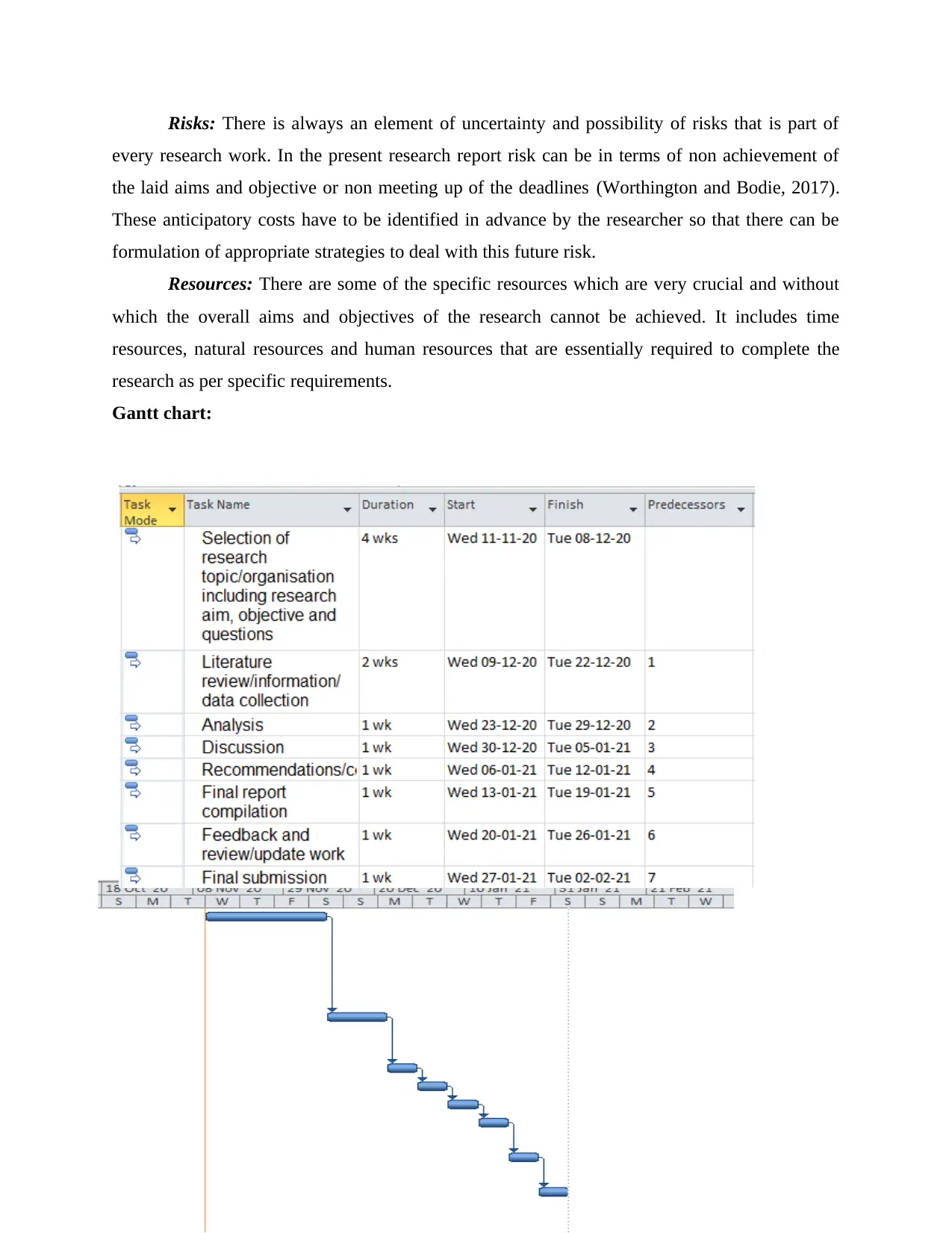
Risks: There is always an element of uncertainty and possibility of risks that is part of
every research work. In the present research report risk can be in terms of non achievement of
the laid aims and objective or non meeting up of the deadlines (Worthington and Bodie, 2017).
These anticipatory costs have to be identified in advance by the researcher so that there can be
formulation of appropriate strategies to deal with this future risk.
Resources: There are some of the specific resources which are very crucial and without
which the overall aims and objectives of the research cannot be achieved. It includes time
resources, natural resources and human resources that are essentially required to complete the
research as per specific requirements.
Gantt chart:
3
every research work. In the present research report risk can be in terms of non achievement of
the laid aims and objective or non meeting up of the deadlines (Worthington and Bodie, 2017).
These anticipatory costs have to be identified in advance by the researcher so that there can be
formulation of appropriate strategies to deal with this future risk.
Resources: There are some of the specific resources which are very crucial and without
which the overall aims and objectives of the research cannot be achieved. It includes time
resources, natural resources and human resources that are essentially required to complete the
research as per specific requirements.
Gantt chart:
3

4
⊘ This is a preview!⊘
Do you want full access?
Subscribe today to unlock all pages.

Trusted by 1+ million students worldwide
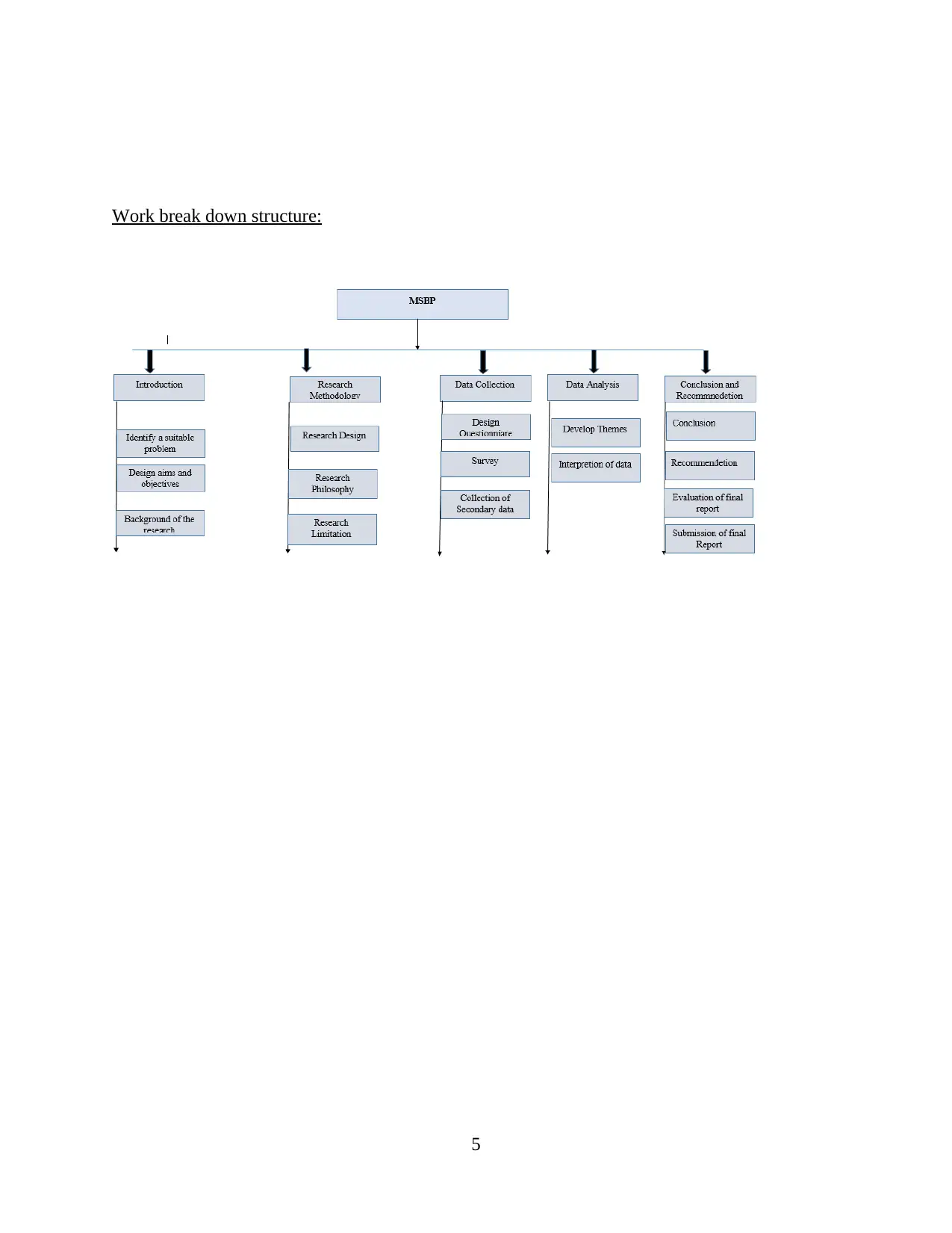
Work break down structure:
5
5
Paraphrase This Document
Need a fresh take? Get an instant paraphrase of this document with our AI Paraphraser
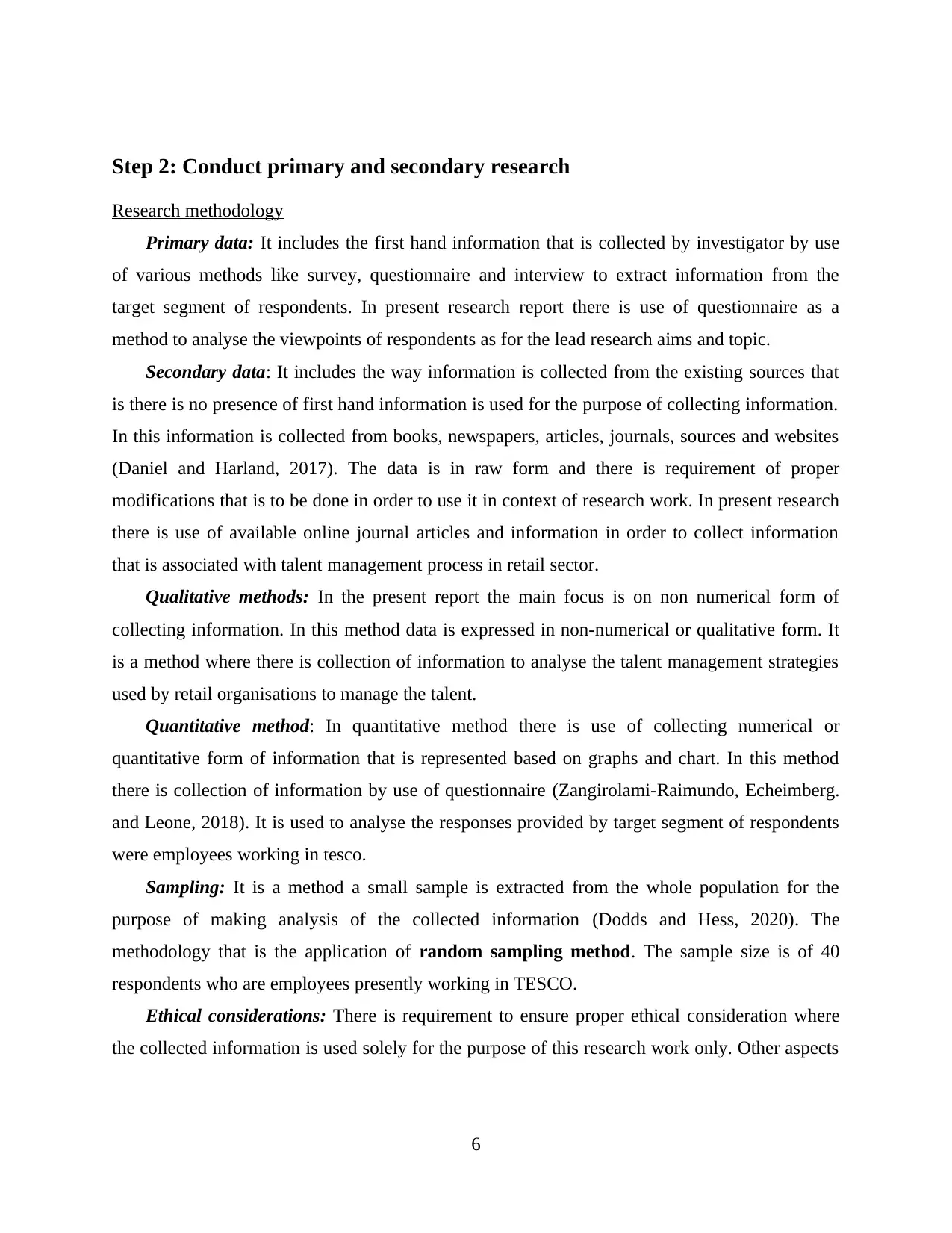
Step 2: Conduct primary and secondary research
Research methodology
Primary data: It includes the first hand information that is collected by investigator by use
of various methods like survey, questionnaire and interview to extract information from the
target segment of respondents. In present research report there is use of questionnaire as a
method to analyse the viewpoints of respondents as for the lead research aims and topic.
Secondary data: It includes the way information is collected from the existing sources that
is there is no presence of first hand information is used for the purpose of collecting information.
In this information is collected from books, newspapers, articles, journals, sources and websites
(Daniel and Harland, 2017). The data is in raw form and there is requirement of proper
modifications that is to be done in order to use it in context of research work. In present research
there is use of available online journal articles and information in order to collect information
that is associated with talent management process in retail sector.
Qualitative methods: In the present report the main focus is on non numerical form of
collecting information. In this method data is expressed in non-numerical or qualitative form. It
is a method where there is collection of information to analyse the talent management strategies
used by retail organisations to manage the talent.
Quantitative method: In quantitative method there is use of collecting numerical or
quantitative form of information that is represented based on graphs and chart. In this method
there is collection of information by use of questionnaire (Zangirolami-Raimundo, Echeimberg.
and Leone, 2018). It is used to analyse the responses provided by target segment of respondents
were employees working in tesco.
Sampling: It is a method a small sample is extracted from the whole population for the
purpose of making analysis of the collected information (Dodds and Hess, 2020). The
methodology that is the application of random sampling method. The sample size is of 40
respondents who are employees presently working in TESCO.
Ethical considerations: There is requirement to ensure proper ethical consideration where
the collected information is used solely for the purpose of this research work only. Other aspects
6
Research methodology
Primary data: It includes the first hand information that is collected by investigator by use
of various methods like survey, questionnaire and interview to extract information from the
target segment of respondents. In present research report there is use of questionnaire as a
method to analyse the viewpoints of respondents as for the lead research aims and topic.
Secondary data: It includes the way information is collected from the existing sources that
is there is no presence of first hand information is used for the purpose of collecting information.
In this information is collected from books, newspapers, articles, journals, sources and websites
(Daniel and Harland, 2017). The data is in raw form and there is requirement of proper
modifications that is to be done in order to use it in context of research work. In present research
there is use of available online journal articles and information in order to collect information
that is associated with talent management process in retail sector.
Qualitative methods: In the present report the main focus is on non numerical form of
collecting information. In this method data is expressed in non-numerical or qualitative form. It
is a method where there is collection of information to analyse the talent management strategies
used by retail organisations to manage the talent.
Quantitative method: In quantitative method there is use of collecting numerical or
quantitative form of information that is represented based on graphs and chart. In this method
there is collection of information by use of questionnaire (Zangirolami-Raimundo, Echeimberg.
and Leone, 2018). It is used to analyse the responses provided by target segment of respondents
were employees working in tesco.
Sampling: It is a method a small sample is extracted from the whole population for the
purpose of making analysis of the collected information (Dodds and Hess, 2020). The
methodology that is the application of random sampling method. The sample size is of 40
respondents who are employees presently working in TESCO.
Ethical considerations: There is requirement to ensure proper ethical consideration where
the collected information is used solely for the purpose of this research work only. Other aspects
6
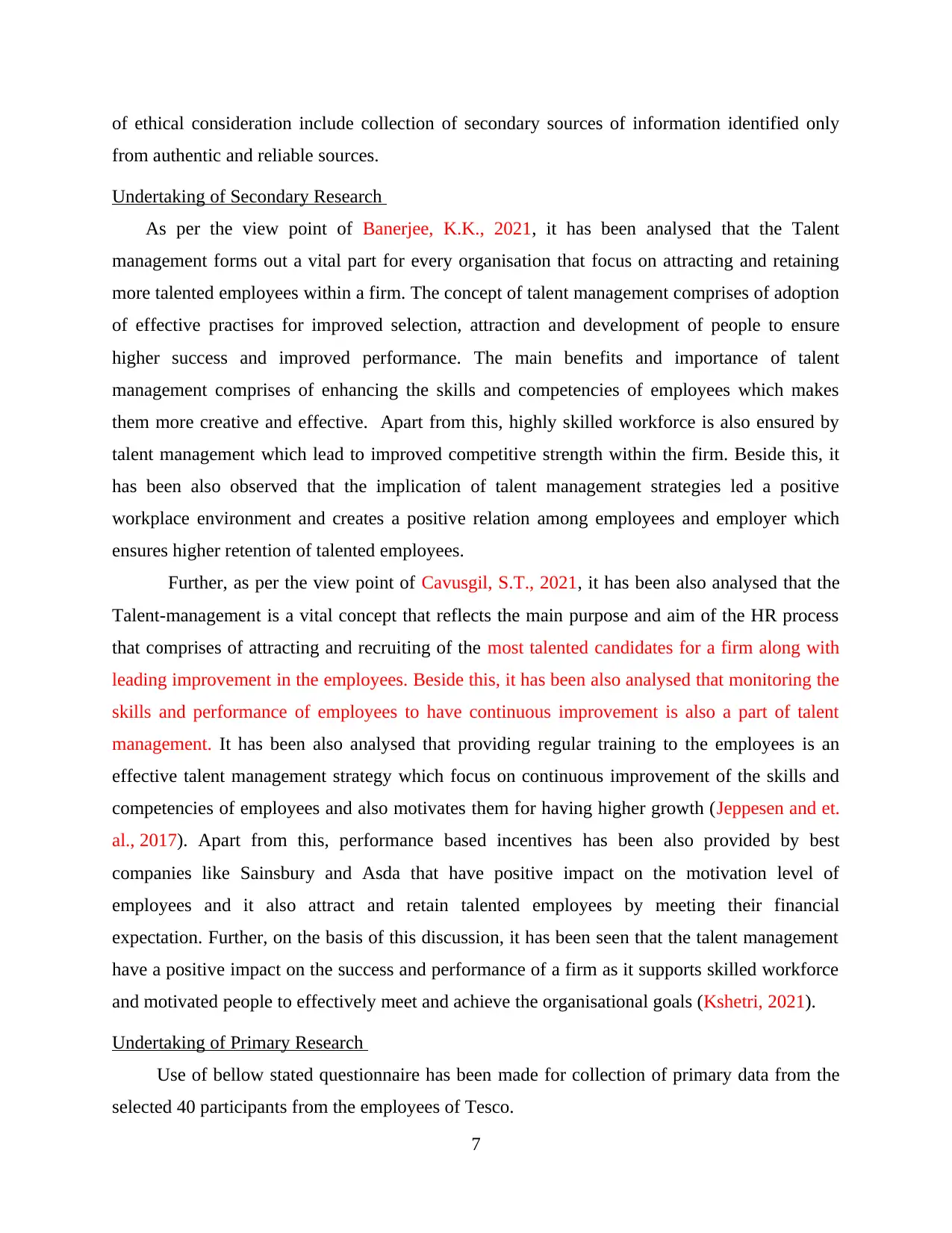
of ethical consideration include collection of secondary sources of information identified only
from authentic and reliable sources.
Undertaking of Secondary Research
As per the view point of Banerjee, K.K., 2021, it has been analysed that the Talent
management forms out a vital part for every organisation that focus on attracting and retaining
more talented employees within a firm. The concept of talent management comprises of adoption
of effective practises for improved selection, attraction and development of people to ensure
higher success and improved performance. The main benefits and importance of talent
management comprises of enhancing the skills and competencies of employees which makes
them more creative and effective. Apart from this, highly skilled workforce is also ensured by
talent management which lead to improved competitive strength within the firm. Beside this, it
has been also observed that the implication of talent management strategies led a positive
workplace environment and creates a positive relation among employees and employer which
ensures higher retention of talented employees.
Further, as per the view point of Cavusgil, S.T., 2021, it has been also analysed that the
Talent-management is a vital concept that reflects the main purpose and aim of the HR process
that comprises of attracting and recruiting of the most talented candidates for a firm along with
leading improvement in the employees. Beside this, it has been also analysed that monitoring the
skills and performance of employees to have continuous improvement is also a part of talent
management. It has been also analysed that providing regular training to the employees is an
effective talent management strategy which focus on continuous improvement of the skills and
competencies of employees and also motivates them for having higher growth (Jeppesen and et.
al., 2017). Apart from this, performance based incentives has been also provided by best
companies like Sainsbury and Asda that have positive impact on the motivation level of
employees and it also attract and retain talented employees by meeting their financial
expectation. Further, on the basis of this discussion, it has been seen that the talent management
have a positive impact on the success and performance of a firm as it supports skilled workforce
and motivated people to effectively meet and achieve the organisational goals (Kshetri, 2021).
Undertaking of Primary Research
Use of bellow stated questionnaire has been made for collection of primary data from the
selected 40 participants from the employees of Tesco.
7
from authentic and reliable sources.
Undertaking of Secondary Research
As per the view point of Banerjee, K.K., 2021, it has been analysed that the Talent
management forms out a vital part for every organisation that focus on attracting and retaining
more talented employees within a firm. The concept of talent management comprises of adoption
of effective practises for improved selection, attraction and development of people to ensure
higher success and improved performance. The main benefits and importance of talent
management comprises of enhancing the skills and competencies of employees which makes
them more creative and effective. Apart from this, highly skilled workforce is also ensured by
talent management which lead to improved competitive strength within the firm. Beside this, it
has been also observed that the implication of talent management strategies led a positive
workplace environment and creates a positive relation among employees and employer which
ensures higher retention of talented employees.
Further, as per the view point of Cavusgil, S.T., 2021, it has been also analysed that the
Talent-management is a vital concept that reflects the main purpose and aim of the HR process
that comprises of attracting and recruiting of the most talented candidates for a firm along with
leading improvement in the employees. Beside this, it has been also analysed that monitoring the
skills and performance of employees to have continuous improvement is also a part of talent
management. It has been also analysed that providing regular training to the employees is an
effective talent management strategy which focus on continuous improvement of the skills and
competencies of employees and also motivates them for having higher growth (Jeppesen and et.
al., 2017). Apart from this, performance based incentives has been also provided by best
companies like Sainsbury and Asda that have positive impact on the motivation level of
employees and it also attract and retain talented employees by meeting their financial
expectation. Further, on the basis of this discussion, it has been seen that the talent management
have a positive impact on the success and performance of a firm as it supports skilled workforce
and motivated people to effectively meet and achieve the organisational goals (Kshetri, 2021).
Undertaking of Primary Research
Use of bellow stated questionnaire has been made for collection of primary data from the
selected 40 participants from the employees of Tesco.
7
⊘ This is a preview!⊘
Do you want full access?
Subscribe today to unlock all pages.

Trusted by 1+ million students worldwide
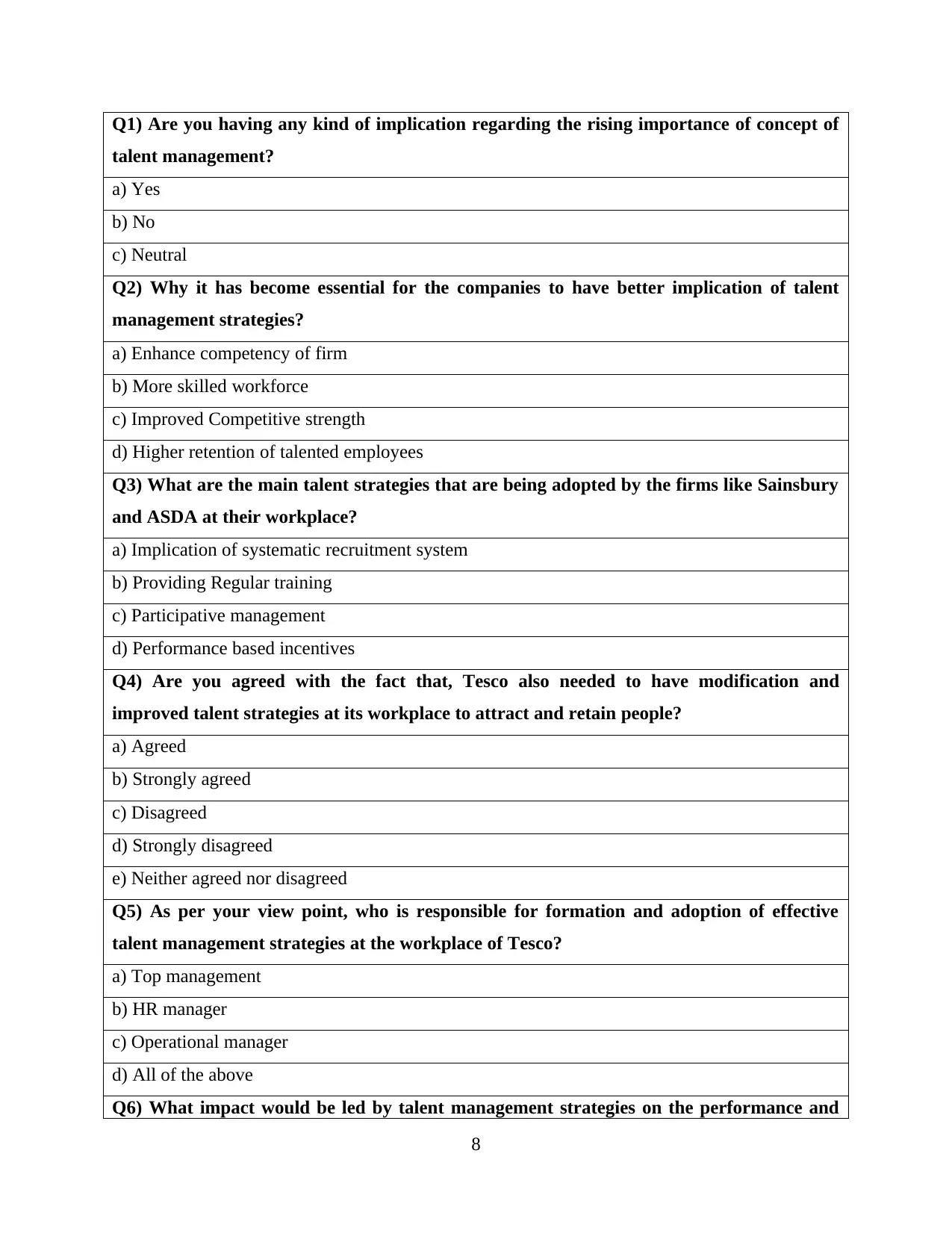
Q1) Are you having any kind of implication regarding the rising importance of concept of
talent management?
a) Yes
b) No
c) Neutral
Q2) Why it has become essential for the companies to have better implication of talent
management strategies?
a) Enhance competency of firm
b) More skilled workforce
c) Improved Competitive strength
d) Higher retention of talented employees
Q3) What are the main talent strategies that are being adopted by the firms like Sainsbury
and ASDA at their workplace?
a) Implication of systematic recruitment system
b) Providing Regular training
c) Participative management
d) Performance based incentives
Q4) Are you agreed with the fact that, Tesco also needed to have modification and
improved talent strategies at its workplace to attract and retain people?
a) Agreed
b) Strongly agreed
c) Disagreed
d) Strongly disagreed
e) Neither agreed nor disagreed
Q5) As per your view point, who is responsible for formation and adoption of effective
talent management strategies at the workplace of Tesco?
a) Top management
b) HR manager
c) Operational manager
d) All of the above
Q6) What impact would be led by talent management strategies on the performance and
8
talent management?
a) Yes
b) No
c) Neutral
Q2) Why it has become essential for the companies to have better implication of talent
management strategies?
a) Enhance competency of firm
b) More skilled workforce
c) Improved Competitive strength
d) Higher retention of talented employees
Q3) What are the main talent strategies that are being adopted by the firms like Sainsbury
and ASDA at their workplace?
a) Implication of systematic recruitment system
b) Providing Regular training
c) Participative management
d) Performance based incentives
Q4) Are you agreed with the fact that, Tesco also needed to have modification and
improved talent strategies at its workplace to attract and retain people?
a) Agreed
b) Strongly agreed
c) Disagreed
d) Strongly disagreed
e) Neither agreed nor disagreed
Q5) As per your view point, who is responsible for formation and adoption of effective
talent management strategies at the workplace of Tesco?
a) Top management
b) HR manager
c) Operational manager
d) All of the above
Q6) What impact would be led by talent management strategies on the performance and
8
Paraphrase This Document
Need a fresh take? Get an instant paraphrase of this document with our AI Paraphraser
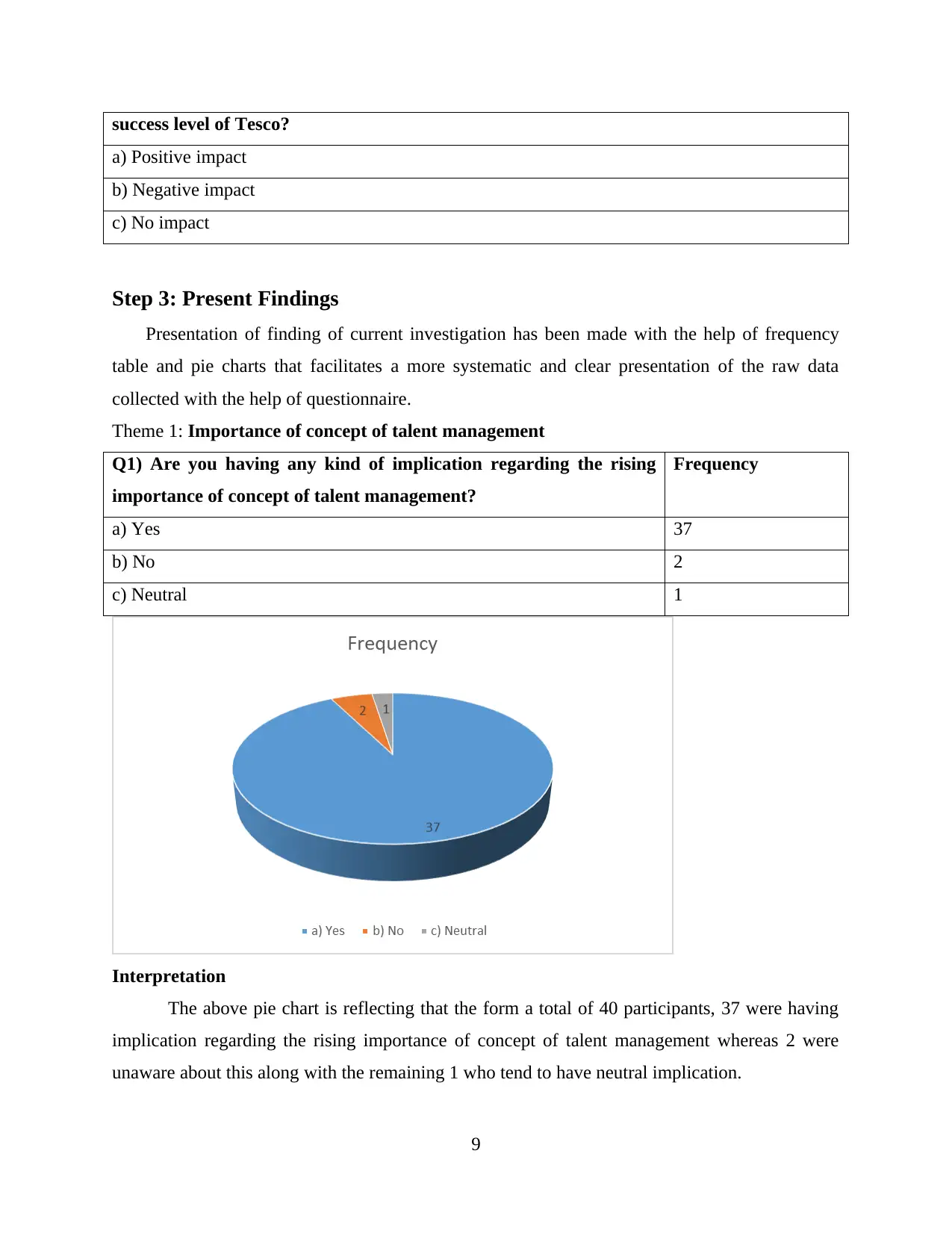
success level of Tesco?
a) Positive impact
b) Negative impact
c) No impact
Step 3: Present Findings
Presentation of finding of current investigation has been made with the help of frequency
table and pie charts that facilitates a more systematic and clear presentation of the raw data
collected with the help of questionnaire.
Theme 1: Importance of concept of talent management
Q1) Are you having any kind of implication regarding the rising
importance of concept of talent management?
Frequency
a) Yes 37
b) No 2
c) Neutral 1
Interpretation
The above pie chart is reflecting that the form a total of 40 participants, 37 were having
implication regarding the rising importance of concept of talent management whereas 2 were
unaware about this along with the remaining 1 who tend to have neutral implication.
9
a) Positive impact
b) Negative impact
c) No impact
Step 3: Present Findings
Presentation of finding of current investigation has been made with the help of frequency
table and pie charts that facilitates a more systematic and clear presentation of the raw data
collected with the help of questionnaire.
Theme 1: Importance of concept of talent management
Q1) Are you having any kind of implication regarding the rising
importance of concept of talent management?
Frequency
a) Yes 37
b) No 2
c) Neutral 1
Interpretation
The above pie chart is reflecting that the form a total of 40 participants, 37 were having
implication regarding the rising importance of concept of talent management whereas 2 were
unaware about this along with the remaining 1 who tend to have neutral implication.
9
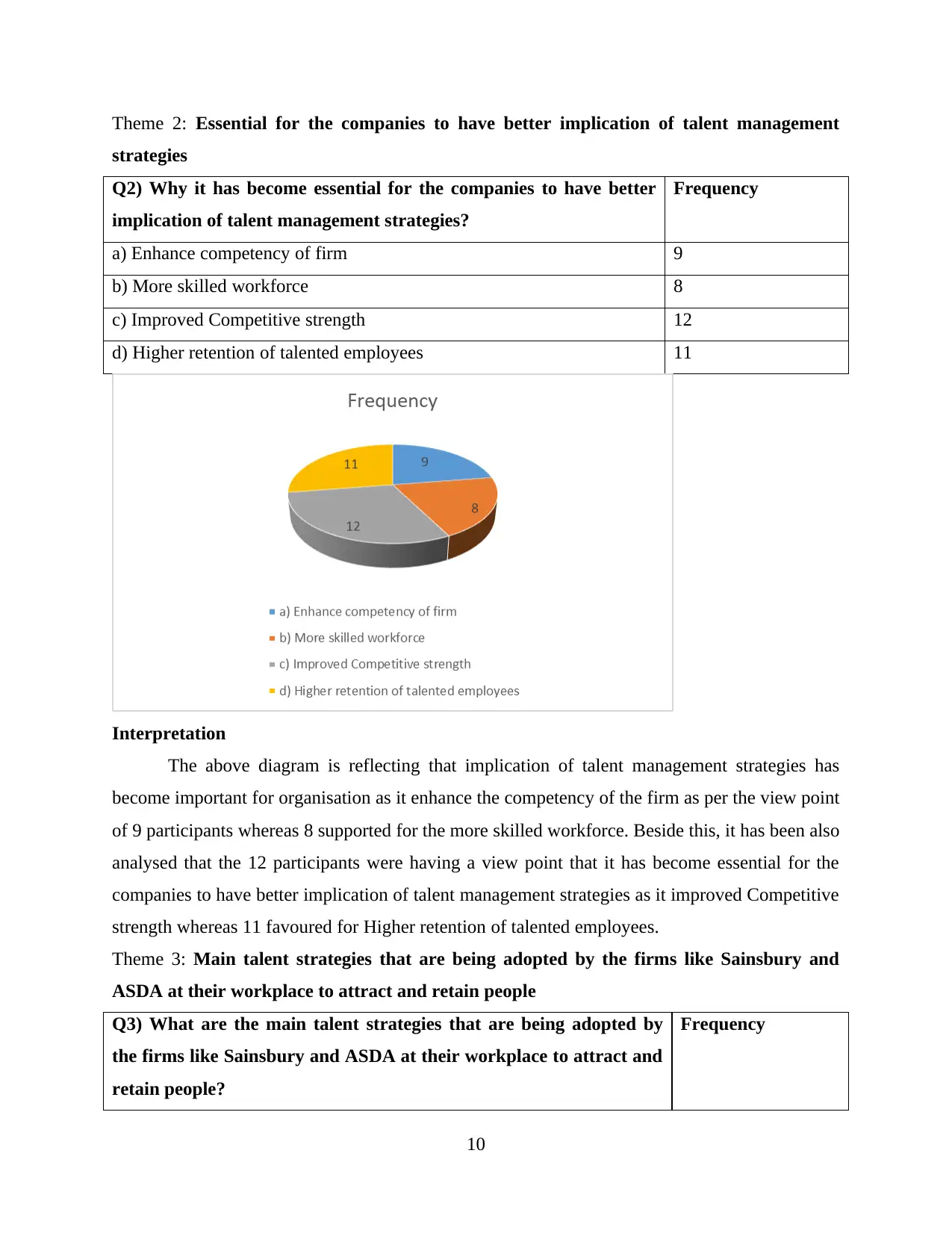
Theme 2: Essential for the companies to have better implication of talent management
strategies
Q2) Why it has become essential for the companies to have better
implication of talent management strategies?
Frequency
a) Enhance competency of firm 9
b) More skilled workforce 8
c) Improved Competitive strength 12
d) Higher retention of talented employees 11
Interpretation
The above diagram is reflecting that implication of talent management strategies has
become important for organisation as it enhance the competency of the firm as per the view point
of 9 participants whereas 8 supported for the more skilled workforce. Beside this, it has been also
analysed that the 12 participants were having a view point that it has become essential for the
companies to have better implication of talent management strategies as it improved Competitive
strength whereas 11 favoured for Higher retention of talented employees.
Theme 3: Main talent strategies that are being adopted by the firms like Sainsbury and
ASDA at their workplace to attract and retain people
Q3) What are the main talent strategies that are being adopted by
the firms like Sainsbury and ASDA at their workplace to attract and
retain people?
Frequency
10
strategies
Q2) Why it has become essential for the companies to have better
implication of talent management strategies?
Frequency
a) Enhance competency of firm 9
b) More skilled workforce 8
c) Improved Competitive strength 12
d) Higher retention of talented employees 11
Interpretation
The above diagram is reflecting that implication of talent management strategies has
become important for organisation as it enhance the competency of the firm as per the view point
of 9 participants whereas 8 supported for the more skilled workforce. Beside this, it has been also
analysed that the 12 participants were having a view point that it has become essential for the
companies to have better implication of talent management strategies as it improved Competitive
strength whereas 11 favoured for Higher retention of talented employees.
Theme 3: Main talent strategies that are being adopted by the firms like Sainsbury and
ASDA at their workplace to attract and retain people
Q3) What are the main talent strategies that are being adopted by
the firms like Sainsbury and ASDA at their workplace to attract and
retain people?
Frequency
10
⊘ This is a preview!⊘
Do you want full access?
Subscribe today to unlock all pages.

Trusted by 1+ million students worldwide
1 out of 29
Related Documents
Your All-in-One AI-Powered Toolkit for Academic Success.
+13062052269
info@desklib.com
Available 24*7 on WhatsApp / Email
![[object Object]](/_next/static/media/star-bottom.7253800d.svg)
Unlock your academic potential
Copyright © 2020–2025 A2Z Services. All Rights Reserved. Developed and managed by ZUCOL.




